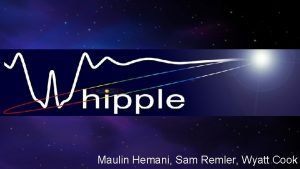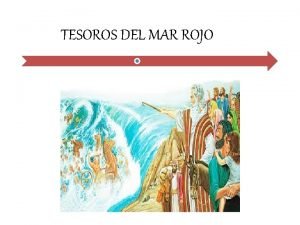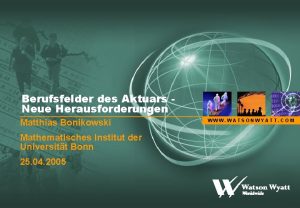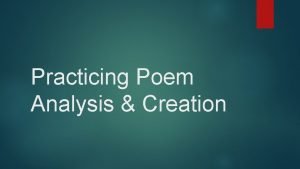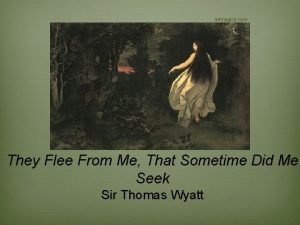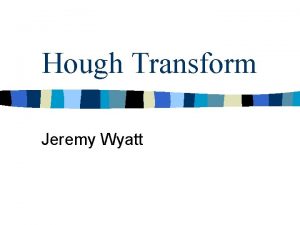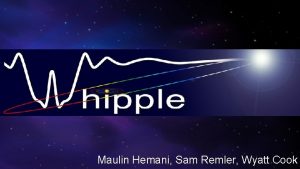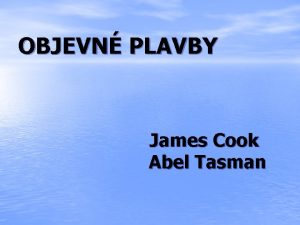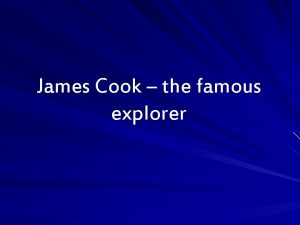Maulin Hemani Sam Remler Wyatt Cook What is




















- Slides: 20

Maulin Hemani, Sam Remler, Wyatt Cook

What is Whipple? ● Whipple will reach much deeper into the unexplored frontier of our outer solar system than any other mission, current or proposed ● Theory says that the Oort Cloud extends 20, 000 AU’s beyond the sun ● Whipple is an opportunity to extend our observational horizon by almost double!

What is Whipple? (cont) ● With very limited light, objects are difficult to detect directly against the blackness of space ● These objects hold clues to the evolution of our Solar System ● Using Blind Occultation, Whipple will monitor tens of thousands of stars trying to spot their shadows.

Background

Kuiper Belt ● The Kuiper Belt is an elliptical plane in space spanning from 30 -50 AU ● It is similar to the asteroid belt between Mars and Jupiter but it is believed to be more icy than rocky ● Thousands of bodies with diameters of 100 km+ and trillions of bodies total ● The Kuiper belt contains the remnants from the beginning of the solar system and can provide valuable insights into the formation of the solar system ● Pluto, Eris and other dwarf planets are Kuiper Belt Object (KBO)

Planet 9 ● Believed to orbit the sun at 600 times farther than the orbit of the earth ● Planet has never been seen directly but has been inferred from gravitational effects of other KBO’s ● Believed to be close to Earth’s size but 10 times earth’s mass

Oort Cloud ● Believed to be an icy debris that surrounds our solar system ● Could extend up to ⅓ of the way from our star to the next ● At this point, the Oort Cloud is all theory ● Population estimates suggest that the outer cloud is ∼ 1012 comets with nuclei >2 km in diameter ● This leads to an estimate of >7 M⊕ for the total mass of comets in the Oort Cloud

Blind Occultation Technique

Occultation Technique ● ● Measuring star intensity 7 sample running average 256 sample running average If noticeable difference then evaluate numbers manually; can determine star locations in Oort cloud. ● Diameter of object determined by the amplitude, and the duration of this change in flux shows how far the object is away.

See more stars ● The telescope will have three frequency modes: 5 Hz, 10 Hz, and 40 Hz ● 80, 000 stars at 5 Hz ● 40, 000 stars at 10 Hz ● 10, 000 stars at 40 Hz ● Different stars detectable at different frequencies

Other Applications of this Technology ● Improve telescope technology we are using on Earth and on Hubble ○ Taiwanese Astronomical Occultation Survey ● See more going on in the outer solar system, from Earth ● Help us become less reliant on light for our looks into the solar system ● Potentially will make way into mainstream cameras for better focal depth in typical pictures.

Key Components of Whipple The Whipple Spacecraft will include: ● The Telescope ● Very large camera + imagers ● Telecom Components Too early in the process for concrete plans of the spacecraft

Learnings from Whipple ● We have never explored this far out into the solar system before! ● We can learn about these far away bodies and map their presence in space ● We can start seeing what is currently “invisible” to us and our current technology

Learnings from Whipple (cont) ● Specifically, we will see and learn about a large quantity of new bodies in space ● By observing the Oort Cloud, we can definitively prove its existence. ● Evolution of Solar System ->

Learn about evolution of Solar System

Evolutionary Models ● Building off the last slide, the insights and data that we can garner from observations from Whipple can be used to improve as well as develop new formation and evolutionary models of the Solar System ● With more accuracy, these models can better inform us about how Solar Systems form

Impacts on Earth ● Doesn’t necessarily inform us about sustainability on Earth ● However, it certainly benefits humanity overall: ○ Innovative new technology ○ Never before seen pictures (front page headlines!) ○ Better understanding of the far outer Solar System and how our Solar System formed

Risks ● Technology needs to become fully robust -- Harvard continues to test it in its labs to refine ● Full Costs haven’t been determined yet

Next Steps ● More Funding! ● Spacecraft plans need to be designed and developed ● Determine possible Extension missions

Conclusion ● The Whipple mission will teach us about an entirely new and vast part of our Solar System, currently unexplored ● It will use exciting new technology ● It’s a low risk, high reward mission
 Maulin hemani
Maulin hemani Ron wyatt la sangre de cristo
Ron wyatt la sangre de cristo Ronald wyatt md
Ronald wyatt md Sonnets of wyatt and surrey
Sonnets of wyatt and surrey Sir thomas wyatt whoso list to hunt
Sir thomas wyatt whoso list to hunt Tumba de amram
Tumba de amram Ron wyatt mer rouge
Ron wyatt mer rouge My galley charged with forgetfulness summary
My galley charged with forgetfulness summary Tesoros encontrados en el mar
Tesoros encontrados en el mar Wyatt bonikowski
Wyatt bonikowski Wyatt horan
Wyatt horan Cruce del mar rojo
Cruce del mar rojo Nuweiba beach red sea crossing
Nuweiba beach red sea crossing Thomas wyatt farewell love
Thomas wyatt farewell love Michelle wyatt
Michelle wyatt They flee from me by sir thomas wyatt
They flee from me by sir thomas wyatt Jeremy c wyatt
Jeremy c wyatt Getting ready to cook
Getting ready to cook Thomas cook organisational structure
Thomas cook organisational structure The great water giant poem
The great water giant poem What market forms of meat that is recently slaughtered
What market forms of meat that is recently slaughtered
